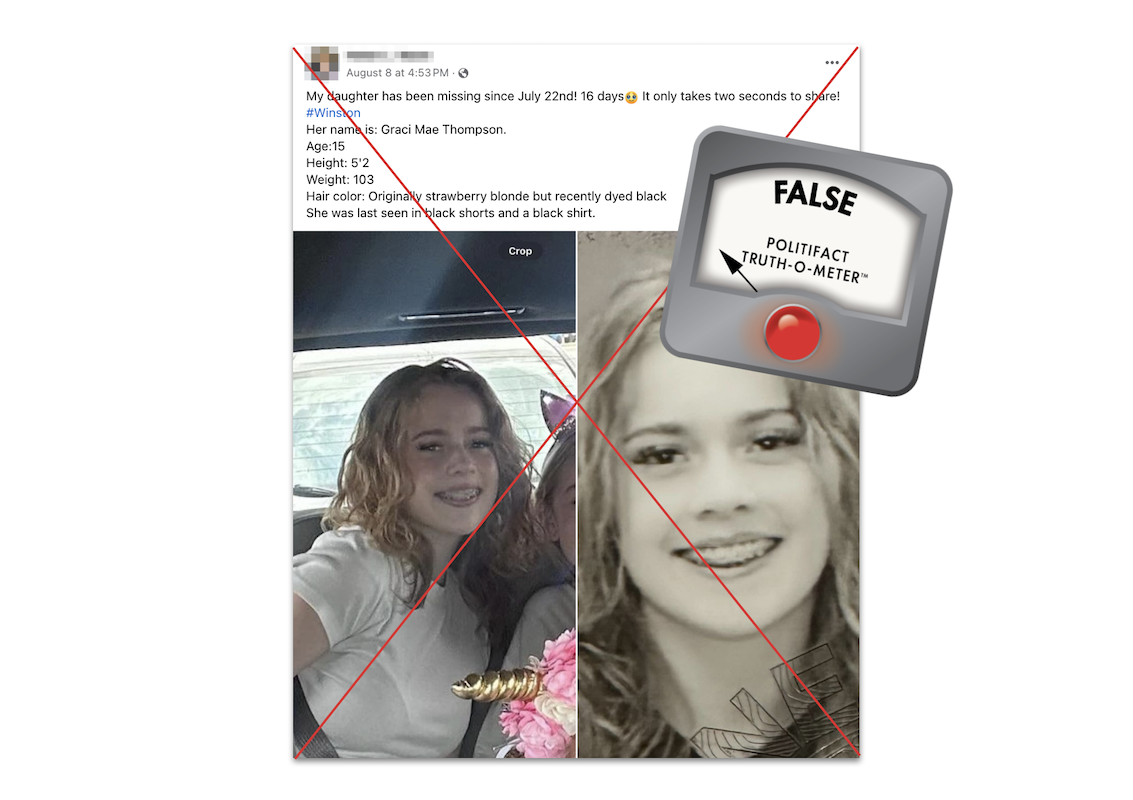Gracie Mae Thompson: Missing Girl Scam? Uncovering The Truth & What You Need To Know
Is the image of a smiling girl, shared widely on social media, actually a call for help, or is it something far more sinister? Recent investigations have revealed a disturbing trend of viral posts claiming to be about missing children, that are, in reality, elaborate scams designed to exploit public sympathy and drain valuable resources from legitimate search efforts.
The narrative began to unfold in early August 2024, when posts concerning a missing girl named Gracie Mae Thompson flooded Facebook feeds. The posts indicated that Gracie's disappearance allegedly occurred on July 22, 2024. The story tugged at the heartstrings of many, with users eagerly sharing the posts, hoping to aid in the search. The posts described Gracie as 5 feet 5 inches tall, weighing 160 pounds when last seen, with brown eyes and brown hair. Accompanying the description were two photos of a girl, seemingly smiling, further amplifying the emotional appeal and encouraging shares.
However, despite the widespread dissemination of information, serious questions arise. A post from August 8th, 2024, showcased the missing girl from various locations that included a public safety notice. Despite the heart-wrenching details, law enforcement agencies have been unable to confirm any legitimate investigation related to a Gracie Mae Thompson. This raises red flags, suggesting the story might be a hoax.
- Mimms Case Analysis Traffic Stop Search Explained
- Williamson Sons Funeral Home In Soddy Daisy Honoring Loved Ones
| Category | Details |
|---|---|
| Name | Gracie Mae Thompson |
| Alleged Disappearance Date | July 22, 2024 |
| Age (as per posts) | 15 years old |
| Location (as per posts) | Tomball, Texas |
| Height | 5 feet 5 inches |
| Weight | 160 pounds |
| Hair Color | Brown |
| Eye Color | Brown |
| Key Concern | Scam, Viral Hoax |
| Official Confirmation | No official confirmation of disappearance from law enforcement agencies. |
| Reference Link | Snopes (For general fact-checking) |
The alarming spread of such scams has become a significant concern for organizations like the National Center for Missing & Exploited Children (NCMEC). Hartmann, a representative of NCMEC, highlighted the detrimental impact of these viral hoaxes, noting that they divert resources away from actual missing persons cases. The time spent addressing inquiries and debunking fake stories hampers the organization's ability to focus on genuine victims and their families.
The recurring pattern of these deceptive posts is particularly troubling. The posts often originate with an emotional appeal, designed to go viral quickly. These tactics prey on the public's inherent compassion and willingness to help, causing a surge in shares and comments, increasing visibility and amplifying the reach of the hoax. Malware tips have labeled this particular tactic the "missing girl scam," emphasizing its deceptive nature and the potential harm it can cause.
The absence of credible information is a telltale sign. In the case of Gracie Mae Thompson, no news outlets or police departments have reported her disappearance. Legitimate cases of missing persons attract immediate media attention and are actively investigated by law enforcement. The silence from these official channels is a strong indicator that the story might be fabricated. If Gracie was a real missing girl then news sites and police would be reporting her disappearance.
- Decoding Lemon Party Meaning Origin What You Should Know
- Fort Worth Isd 2024 Spelling Bee Volunteers More
Similar incidents have underscored the trend of online scams. In a separate, unrelated case, a viral missing persons photo, earlier this week, also made claims about a missing girl named Gracie Mae Thompson. These types of deceptive campaigns use emotional stories to generate attention. A photo of a young girl named gracie mae thompson is circulating on social media saying that she is missing. However, as many have confirmed, the photo and the link about the girl is fake and most likely a scam. It's important to verify the information from official sources.
The proliferation of the Gracie Mae Thompson story serves as a stark reminder of the need for vigilance and critical thinking online. While the impulse to share and help is admirable, it is essential to verify information before spreading it further. This can be achieved by cross-referencing information with established news sources, law enforcement agencies, and reputable fact-checking websites such as Snopes. This proactive approach can help to prevent the spread of misinformation and protect the resources and efforts dedicated to helping genuine victims.
Cyber sleuths have pointed out the ease with which these scams are created. The posts often include fabricated details, designed to evoke a strong emotional response. They may include appeals to the victims friends and family, a detailed description of the missing person, and even a call to action, urging viewers to share the post or contact the authorities.
The impact of these scams extends far beyond the immediate confusion and distress they cause. They erode public trust, desensitize people to legitimate cases, and hamper the efforts of organizations working to locate missing individuals. The resources consumed by these hoaxes could otherwise be used to assist families of real victims.
In contrast to the Gracie Mae Thompson case, it's vital to look at verified cases. For instance, in Manchester, New Hampshire, a real missing person case has been active for some time. Gracie Silver, a 15-year-old girl, went missing on September 11, 2023. The National Center for Missing & Exploited Children website and the Manchester Police Department has actively sought the public's assistance in locating her. Gracie has green eyes and brown hair, but her hair was dyed green when she was last seen, according to a listing on the national center for missing and exploited children website. This example highlights the critical need to differentiate between genuine cases and scams, as the former are supported by real investigations and backed by credible information.
The rise in missing person scams highlights the need for better digital literacy. A closer look at a Facebook post on August 8th, 2024, which includes two photos of a smiling girl and a public safety notice illustrates how these deceptive posts can spread. The fact that the post appears to be from the girl's mother, however, police confirmed that there's no record of a gracie mae thompson, is a perfect example of the importance of verification. The use of direct links and archive links, combined with a public safety notice, aims to give the false information an air of credibility, but in reality, it is an attempt to exploit the public's concern.
The posts say that the girl is from Tomball, Texas, and is 15 years old. The details match, but it is important to verify the information with law enforcement. A similar event involved Lauren Thompson, a mother of three, who went missing in January. Although the cases are different, the approach of sharing the information with emotional posts is very similar. Skeletal remains were located in July of this year.
The public's response to such scams often validates the perpetrators' efforts. The posts quickly generate substantial engagement, with users sharing the story and expressing concern. The emotional nature of the content encourages users to react quickly without verifying the information. This creates a vicious cycle, with the hoax gaining momentum and wider reach.
The "missing girl scam" is not new. Similar schemes have emerged in the past, often focusing on young girls or children. The effectiveness of these scams is linked to the emotional impact of the content. The vulnerability of the target demographic and the overall appeal of the narrative make them attractive targets for these types of fraudulent activities. The unverified nature of the claims serves as a key indicator of a potential scam, which highlights the need to stay informed and to verify the information.
The case of Gracie Mae Thompson, and the other instances cited, should be viewed as a learning opportunity for all social media users. The more informed users are, the better equipped they will be to identify and report fraudulent posts. By staying informed about the tactics used by scammers, people can help protect others. This ultimately contributes to the safety and well-being of children, and also ensures that the efforts of search teams and law enforcement agencies are not compromised by fake information.
- Nail Contact Dermatitis Causes Treatments Your Guide
- Onlytik What You Need To Know Now Amp Future Trends

Graci Mae Thompson missing case goes viral in Texas, but its

Fact Check Don’t fall for posts saying a teen named ‘Graci Mae

Graci Mae Thompson Missing Girl Facebook Scam Alert What You Need to Know